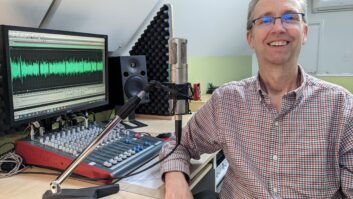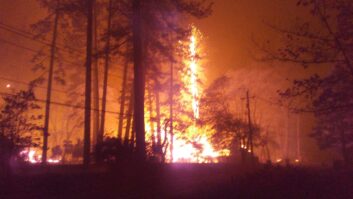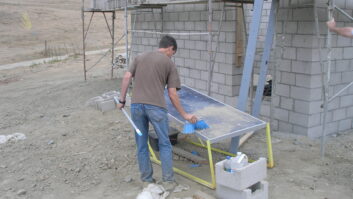
CONTACT, Nev. — For nearly 10 years, this tiny unincorporated town has been home not only to slot machines and blackjack gaming tables, but to the wind-powered radio transmission facility of non-commercial KBSJ(FM).
Contact is 62 miles south of Twin Falls, Idaho. The station’s city of license is Jackpot, Nev., about 15 miles north of Contact.
Station officials believe KBSJ is the only radio station transmitter site to rely on wind power in the country. It recently celebrated the 10th anniversary of the project getting the green light. Radio World wrote about it as construction was nearing completion in 2002.
KBSJ, which has the most powerful FM signal in the Boise State Public Radio network of stations and is heard across parts of Nevada, Idaho and Utah, is a Class C FM at 91.3 MHz with an ERP of 4,700 watts. The station receives network programming via microwave from KBSX(FM) in Twin Falls, Idaho. It is licensed to the Idaho State Board of Education and carries a mixture of programming from National Public Radio, Public Radio International and American Public Media.
The facility depends on strong Nevada winds blowing across the 8,700-foot peak of Ellen D Mountain for its main power source. The moving air — reaching 80 to 100 mph or higher — turns three 10 kW turbines that store power in a nearly 14,000-pound storage battery bank inside the transmitter building. The site has a propane-fired generator for backup power.

Contract Engineer Mike Strolberg stands in front of a turbine hub ready to be lifted into place. The blades, nose cone and alternator are visible. Photos courtesy of KBSJ

KBSJ’s tower has numerous tenants.
The station erected four towers at the mountaintop transmitter site — three for the 10 kW wind turbines, a fourth for the radio station’s antenna. The wind power and transmitter project cost just over $600,000 when it was completed in 2002. Boise State Public Radio received a $251,000 federal Public Telecommunications Facilities Grant for the project, Radio World previously reported.
When Thomas Lowther, chief engineer for Boise State Public Radio, Eastern Region, began designing the transmitter site in 1998, there was no commercial power grid available in this rugged section of northern Nevada. Boise State Public Radio chose wind power in order to complete the project.
“Certainly had power been available when the project was done in 2001 and 2002, we would have chosen that over the wind system. However, at the time, we had to fulfill our construction permits and grant, so we needed to build,” Lowther said.
Commercial power finally arrived at the mountaintop in 2004, but Boise State Public Radio declined to pay the cost to hook up, estimated at $100,000. The organization recouped its share of the additional cost of installing the wind system within five years through energy savings.
Mountaintop challenges
Through the years, the wind system has presented challenges and some dependability issues, Lowther said. It has experienced occasional failures yet has been mostly successful.
A wind system failure as recent as November 2010 caused the transmitter to go down; the problem was related to the power inverter. “That’s the core and brain of the wind system,” Lowther said.

The mountaintop ridgeline and KBSJ wind turbines in winter.

Static suppression coils on the turbine power cables.
“We had several inverter failures early in the project. In 2003, we replaced the Xantrex/Trace inverter with one from Exceltech. We have had almost no problems since. The recent problem was caused by a control card failure,” Lowther said. “The unit is modular, which means that most failures do not bring the site down. However, this one did.”
“We’ve had several catastrophic wind turbine failures, where a machine self-destructs. We’ve worked with the manufacturer — Bergey Windpower — to identify the underlying cause for such failures,” he continued. “The main problem appears to be blade flutter. Bergey is working on redesigning the blades to mitigate the problem.”
Blade flutter is an oscillation condition that can be caused by excessively high winds that stress rotor components and ultimately cause turbine failure, according to the manufacturer.
Lowther is based out of Twin Falls; he went so far as to visit Bergey’s manufacturing plant in Norman, Okla., to receive extra training on its wind power system.
“(Bergey’s) turbines are installed chiefly in moderate wind energy areas such as the Midwest and Texas. Our site is classified as a high-wind energy area. As such, while the wind at the site is not exceeding the design specifications, it is sufficient energy to stress the design and reveal flaws,” he said.
Lowther describes KBSJ’s wind power system as “small wind turbines,” not to be confused with huge utility-scale turbines. “There is a high survivability gap between small and large turbines,” he said.
The rotor diameter of the KBSJ turbines is 22 feet, Lowther said; utility scale turbines can have rotor diameters of up to 200 to 300 feet.

The Exeltech inverter.
(click thumbnail)
The DC source center is the heart of the DC buss in this 48 VDC system. Also visible are the top of the battery bank rack (lower right) and one of the three VCS charge controllers.
“Bergey has experimented with both longer and short blades at our site. Our small wind turbine is designed to fulfill the needs of an individual site.” Those can be homes, farms or telecommunication sites, he said.
A wind system data logger was installed at the site in 2007 to gather data on the blade flutter problem, Lowther said.
Mike Bergey, president of Bergey Windpower, said, “KBSJ is still a learning experience for us. The mountain is a turbine killer due to the extreme wind and topology. We have turbines at 7,000 sites all over the world and this is the most difficult site we have.
“What makes it so difficult is that you can have wind gusts of up to 120 mph that are coming up the hill through the rotor of that turbine at a steep upward angle. The issue is compounded because the site is virtually inaccessible nine months out of the year.”
Company engineers are working to correct design details, Bergey said. “We think we are close, but time will tell.”
The average wind speed on the mountaintop at 100 feet off the ground is 25 miles per hour, Lowther said, which means the area is classified as a wind power Class 7, the highest category, according to the National Renewable Energy Laboratory, a federal lab in Golden, Colo. The lab assesses wind power density in geographic regions and categorizes them in classes based on height above sea level.
Despite the typically heavy wind, seasonal lulls in wind in northern Nevada prevent the wind turbines from producing enough energy in mid-summer, Lowther said. This means the station must rely on its propane-powered backup generator at times.
“We need to run (the generator) for a few hours a week in mid-July until late August. The batteries have a storage capacity of 3,000 amp hours and give us about a day’s worth of backup at full charge.”
Space, access issues
But seasonal lack of access to the mountainous transmitter site has presented challenges, Lowther said. Snow closes the main road by mid-October; it doesn’t typically reopen until early June. “So we have about a four-month window to accomplish maintenance and projects at the site.”
At times, access is limited to four-wheel ATVs, snowmobiles or snowcats, plus the occasional helicopter ride for equipment checks.
KBSJ schedules preventive maintenance visits each year in June and October. During these visits, all aspects of the wind power system are inspected and tested.


The VCS-10 rectifies the voltage from the turbine and puts the power into the DC buss. One charge controller is needed per turbine.
“Routine maintenance includes replacing leading-edge blade tape, checking for loose bolts and other hardware, inspecting for wear and checking alternator output,” he said.
The battery bank is a GNB Absolyte II and uses gel cells with a nominal voltage of 2V. The bank has a design life of 10 to 15 years, so KBSJ will have to replace the bank within the next five years. The current cost for a new bank is $18,000, Lowther said.
“We’ve had to replace a few individual cells the past few years. Individual battery cells are $700 to replace,” he said.
The wind power system could limit KBSJ’s ability to convert to HD Radio broadcasting, Lowther said, since the broadcaster must be certain the power budget from the system allows for the increased power consumption HD would bring.
“Once we iron out the wind system problems, we should be able to convert to HD. We may also have to expand our building to accommodate new equipment such as an HD transmitter.”
The mountaintop facility has turned out to be a popular RF site for a diverse list of clients who have collocated on KBSJ’s tower, Lowther said, including the Idaho State Police, NOAA Weather Radio, Idaho Transportation Department, Enexco Mining and the Elko Amateur Radio Club. All tap into KBSJ’s wind power supply except for the ham group, which located on the site in 2004 after the power grid came to the mountain.
When asked if, in hindsight, he would do anything differently, Lowther said the appeal of the site has caused some overcrowding in KBSJ’s 10-by-20-foot modular transmitter building.

Bighorn sheep typically graze near KBSJ’s tower site.

Three towers support the turning blades.
“The wind power equipment takes up better than half of the structure with controllers, disconnects, inverter rack, power panels and the battery bank. The space problem could have been averted” with a bigger building, he said.
Boise State Public Radio and Bergey Windpower still view KBSJ as a test site for future applications of alternative energy.
Interest from other radio broadcasters with mountaintop sites has been limited, according to Bergey Windpower, mostly because the United States has an extensive electrical grid network. “We are seeing quite a bit of interest from cell phone site operators, particularly overseas where there are tens of thousands off-grid cell sites that cost from up to $50,000 a year to operate from a diesel powered base site,” Mike Bergey said. “There is quite a movement there to reduce operating costs using wind and solar.”
Nevertheless, Lowther says, “This is really a case study from which the industry can learn. Alternative energy can be very useful in broadcasting.
“At this point, the future of wind power for mountaintop broadcast and telecommunications sites is unclear at best. We have a low-power translator in Stanley, Idaho, that has been solar powered for many years. However, full-power sites such as KBSJ require a bigger power budget and need alternative power such as wind.
“I’m confident that the next five years will be better than the first 10. Once those final issues are resolved I will definitely be ready to plan another wind-powered broadcast facility.”
Read past stories in the “Green Radio” series found under the Columns tab at radioworld.com.
Delays & Inaccessibility Are Part of the Experience
Asked for anecdotes about the project, Thomas Lowther came up with a few:
- •“During the excavation for the project, our bulldozer operator discovered that he could not get his ripping tool deep enough. The electrical conduits that would house the cables that carried power from the wind turbines to the building needed to be buried at a certain specified depth. The rock was just too hard. So, we had to hire a crew to use explosives to blast the rock. The procedure was quite interesting, but did cause several days’ delay in the project.”
- •“Helicopter flight days have proven to be some of the most unusual to spend on the mountain. We usually stage our trucks and equipment at a flat spot near at base of the mountain. That way, we use as little ‘rotor time’ as possible ferrying people and things to and from the site.
“It’s interesting to experience the difference in weather conditions just between the bottom and top of the mountain. Many times, we would find the base of the mountain to be cold and calm, while — after a short flight — we would find the top to be very windy and much, much colder. During one of our very first helicopter trips the weather was being uncooperative (as is likely in the winter). We landed on the ridge past the wind turbines and hiked up to the site.
“The pilot kept an eye on the weather while we worked and expressed some concern that we might get ‘socked in’ by clouds and be unable to take off. Most helicopters fly under Visual Flight Rules and the pilot must be able to see the ground at all times while flying. The clouds kept covering the mountain — it appears as fog when you’re in it — and then clearing.
“The pilot said he was going to go to the chopper and get it ready as we were fast losing our weather window. He told us that, if we heard him start up, we’d better hurry and get on board or he might have to leave us at the site. We quickly wrapped things up and headed toward the chopper to leave just as he was beginning the start up sequence. We made it off the mountain and shortly afterwards the clouds did cover it for good.”
- •“On another trip, we were able to land the helicopter on the top of the mountain near the site. The wind was howling (as usual). The pilot checked the outside temperature and calculated the wind chill to be –57 degrees Fahrenheit! We bundled up for the short walk to the building.
“I thought I’d covered all skin, but apparently had some small areas exposed to the elements between my ski goggles and ski mask. The cold air hurt so badly that I thought I might get frostbite on those areas in the brief time it took to transit the 60 feet to the building.”












